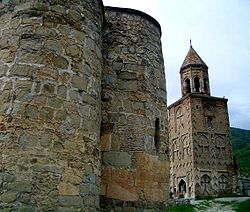
Ninotsminda Cathedral
Encyclopedia

Sagarejo
Sagarejo is a town in Kakheti, Georgia. It is situated east of Georgia’s capital, Tbilisi, and has the population of 12,600 . It serves as an administrative center of the Sagarejo district....
, in the Kakheti
Kakheti
Kakheti is a historical province in Eastern Georgia inhabited by Kakhetians who speak a local dialect of Georgian. It is bordered by the small mountainous province of Tusheti and the Greater Caucasus mountain range to the north, Russian Federation to the Northeast, Azerbaijan to the Southeast, and...
region, Georgia
Georgia (country)
Georgia is a sovereign state in the Caucasus region of Eurasia. Located at the crossroads of Western Asia and Eastern Europe, it is bounded to the west by the Black Sea, to the north by Russia, to the southwest by Turkey, to the south by Armenia, and to the southeast by Azerbaijan. The capital of...
.
Ninotsminda Cathedral is highly significant to the development of Georgian architecture, as it predates Jvari Monastery in Mtskheta
Mtskheta
Mtskheta , one of the oldest cities of the country of Georgia , is located approximately 20 kilometers north of Tbilisi at the confluence of the Aragvi and Kura rivers. The city is now the administrative centre of the Mtskheta-Mtianeti region...
, and served as a model for the development of the later tetraconch
Tetraconch
A tetraconch, from the Greek for "four shells", is a building, usually a church or other religious building, with four apses, one in each direction, usually of equal size. The basic ground plan of the building is therefore a Greek cross...
(four-apse) form. The site is ruins today, with only the eastern apse
Apse
In architecture, the apse is a semicircular recess covered with a hemispherical vault or semi-dome...
and a portion of the western wall remaining. The ruined apse is decorated with 16th century fresco
Fresco
Fresco is any of several related mural painting types, executed on plaster on walls or ceilings. The word fresco comes from the Greek word affresca which derives from the Latin word for "fresh". Frescoes first developed in the ancient world and continued to be popular through the Renaissance...
s of the Hodegetria
Hodegetria
A Hodegetria — or Virgin Hodegetria — is an iconographic depiction of the Theotokos holding the Child Jesus at her side while pointing to Him as the source of salvation for mankind...
, severely vandalised with bullet holes
Lekianoba
Lekianoba was the name given to sporadic forays and marauds by Dagestan clansmen into Georgia from 16th to 19th centuries. The term is derived from Leki, by which the Georgians knew Dagestani peoples, with the suffix –anoba which designates attribution.The attacks from Dagestan began with the...
from Dagestan
Dagestan
The Republic of Dagestan is a federal subject of Russia, located in the North Caucasus region. Its capital and the largest city is Makhachkala, located at the center of Dagestan on the Caspian Sea...
i bandits in the 18th and 19th centuries. Outlines of the foundations indicate that the church originally had an octagonal center, surrounded by corner niches. Historical records indicate that restoration work was undertaken in the 10th and 11th centuries, and also during 1671 and 1774. However, the cathedral collapsed during earthquake
Earthquake
An earthquake is the result of a sudden release of energy in the Earth's crust that creates seismic waves. The seismicity, seismism or seismic activity of an area refers to the frequency, type and size of earthquakes experienced over a period of time...
s in 1824 and 1848 and was not reconstructed.
The large brick
Brick
A brick is a block of ceramic material used in masonry construction, usually laid using various kinds of mortar. It has been regarded as one of the longest lasting and strongest building materials used throughout history.-History:...
belltower within the same complex dates from the reign of King Levan of Kakheti
Levan of Kakheti
Levan also known as Leon , of the Bagrationi Dynasty, was a king of Kakheti in eastern Georgia from 1518/1520 to 1574. He presided over the most prosperous and peaceful period in the history of the Kingdom of Kakheti.- Biography :...
(1520-1574). The lower three stories served as a residence, each floor with a fireplace. The staggered placement of bricks on the exterior façade to form geometric patterns indicates the cultural influence of Safavid Persia, as does the pointed arch over the entrance.
The Ninotsminda complex is surrounded by a fortification, with corner towers and a crenalated curtain wall
Curtain wall (fortification)
A curtain wall is a defensive wall between two bastions of a castle or fortress.In earlier designs of castle the curtain walls were often built to a considerable height and were fronted by a ditch or moat to make assault difficult....
, dating from the 16th-17th centuries. The fortified entrance gate has protruding towers with beehive machicolation
Machicolation
A machicolation is a floor opening between the supporting corbels of a battlement, through which stones, or other objects, could be dropped on attackers at the base of a defensive wall. The design was developed in the Middle Ages when the Norman crusaders returned. A machicolated battlement...
s.
The complex is currently operated as a nunnery by the Georgian Orthodox Church
Georgian Orthodox and Apostolic Church
The Georgian Apostolic Autocephalous Orthodox Church is an autocephalous part of the Eastern Orthodox Church. Since the 4th century AD, Georgian Orthodoxy has been the state religion of Georgia, and it remains the country's largest religious institution....
, and reconstruction work in underway.

